The "One More Move" Story Of Paul Morphy and The Moritz Retzsch Painting
The "one more move" story of Paul Morphy and the Moritz Retzsch "Checkmate" painting has its source in issues of the Columbia Chess Chronicle in the fall of 1888
Source of the "One More Move" Story--The Columbia Chess Chronicle
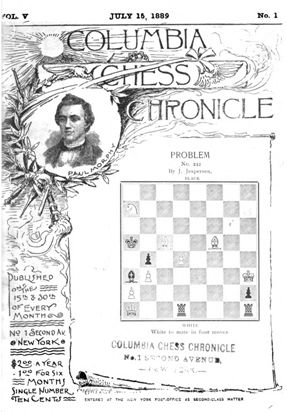 |
In 1888 the “Columbia Chess Chronicle”
professed to be “The Only Weekly Paper In America Devoted Exclusively To This
Intellectual Pastime”. It was published every Saturday at the Columbia Chess
Club, No 1 Second Avenue,
New York. The
above mast head of the Chronicle dated July 15, 1889 bearing Morphy’s picture
is typical for many of the 1888 issues that carried the member interchange about the
famous "Morphy Anecdote".
The popular one more move story as told today
|
The popular story that the king has one more move
is recounted again and again even today about a chess master (often unnamed) who “encounters”
a copy of the Moritz Retzsch painting "Checkmate" (originally titled Die Schachspieler “The Chess
Players”) in a museum. He closely examines the chess board and realizes the
young man’s chess position is not nearly as hopeless as one might first
imagine. |
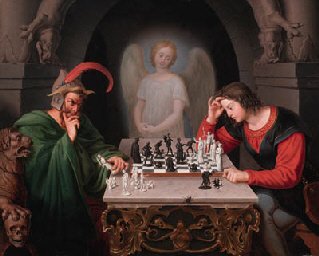
|
The Story's Origin
The "one more move" story was first recounted in print on page 60 of Volume III, Number 7, 8 of the Columbia Chess Chronicle dated August 18, 1888. The article was entitled “Anecdote of Morphy”. The original full text of the anecdote as it was originally published in that issue of the Chronicle is also provided below.
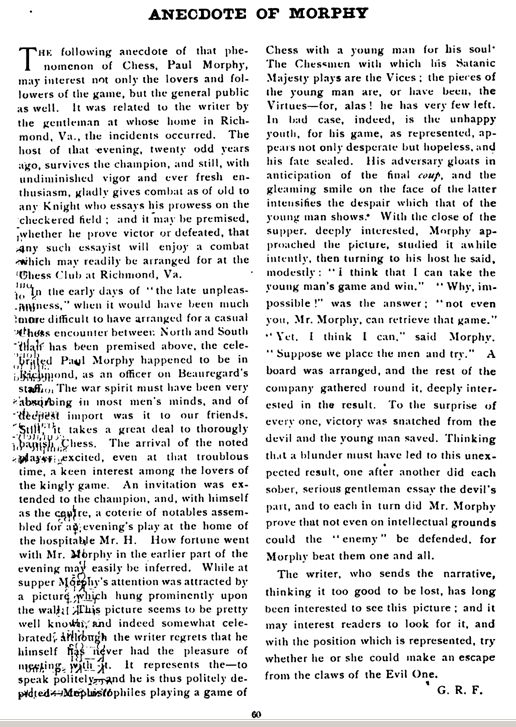
As the text of the original one more move anecdote reveals, Morphy’s famous encounter with a copy of the Retzsch painting occurred in the home of “the hospitable Mr. H” while Morphy was visiting Richmond Virginia. Mr. H was later identified in succeeding letters to the Chronicle discussing the Morphy story to be the Reverend R.R. Harrison:
|
“With the close of supper, deeply interested, Morphy approached the picture, studied it awhile intently, then turning to his host he said, modestly: “I think that I can take the young man’s game and win.” |
 Source: Christie's |
Morphy was challenged as follows: “not even you, Mr. Morphy, can retrieve that game.” Morphy replied “Suppose we place the men and try.” The anecdote continues:
|
“A board was arranged, and the rest of the company gathered round it, deeply interested in the result. To the surprise of every one, victory was snatched from the devil and the young man saved.” |
The original "one more move" anecdote appears to indicate that, unlike many of today’s modern day versions of the story, more than one move was likely necessary to “save” the young man. But that minor discrepancy is easily excused by the natural tendency to slightly embellish what later letters to the Chronicle's editor reveal to be an substantially true and accurate story.
|
Retzsch’s painting as well as his various early engravings of “The
Chess Players” were both popular at the time the Paul Morphy one more move anecdote was first
published in the Chronicle. That fact is confirmed by a response to the original anecdote found in the
later September 8, 1888 edition (Volume III, Number 10). |
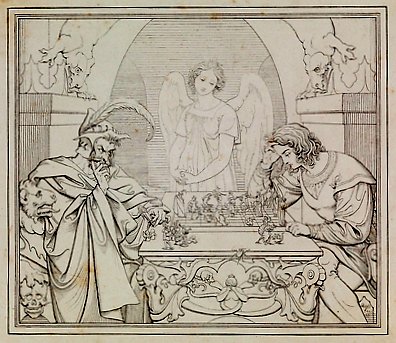 Source: Met (as enhanced) |
The First Objection By "Dayton" Is Defended And Apparently Satisfied
On page 84 of that edition of the Columbia Chess Chronicle is found a response to G.R.F.’s previous “Anecdote” about Morphy’s encounter with the painting. The writer “Dayton” states that he was in possession of a copy of a line engraving of “The Chess Players” by Retzsch. He expresses doubt about the Morphy one more move story because his copy of the line engraving does not provide sufficient detail of the exact placement of the pieces on the chess board!
Dayton’s
post on page 84 of the Chronicle is also provided below:
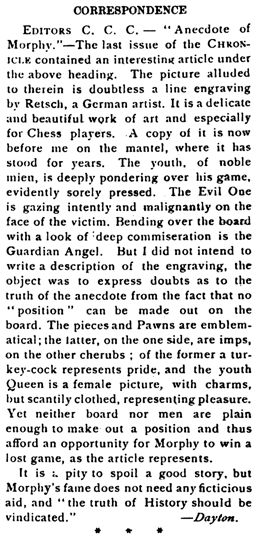
Dayton’s letter to the editor resulted in a later response
by someone identified only as "F.G.J." on page 93 of the September 15, 1888 edition of the Chronicle offering support for the original Morphy anecdote. F.G.J. suggests the particular engraving owned
by Dayton might
not show the particular chess pieces as clearly as the copy of the Reverend
Harrison’s painting. A copy of F.G.J.'s letter as posted in the Chronicle is also provided below.
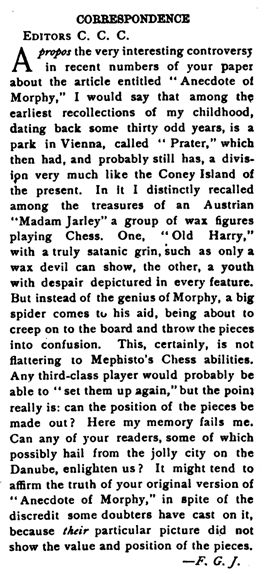
The controversy regarding Dayton’s inability to view
the position of the chess pieces in Retzsch’s painting was apparently resolved in
a letter to the September 22, 1888 issue, Volume III, Number 12. On page 102 of
the Columbia Chess Chronicle Chas. A. Gilberg posted what he believed the
position of the chess pieces to be in Retzsch's painting. A copy of Gilberg's post to the Chronicle is also provided below
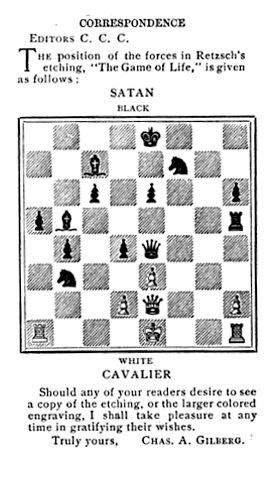
Three More Objections To the Morphy Story Are Raised By "Galbreath"
Beginning at the bottom right on page 136 and
continuing onto page 137 of the October 20, 1888 Edition (Volume III Number 16)
of the Columbia Chess Chronicle another critic of the Morphy story surfaced. One "Jno. A. Galbreath of Vicksburgh, Miss." He offered three specific criticisms of the original Morphy anecdote. A copy of Galbreath's letter to the Chronicle found on those two pages is also provided below. Read down through all parts of the left hand column for continuity and finish with the column on the right.
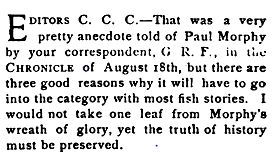 |
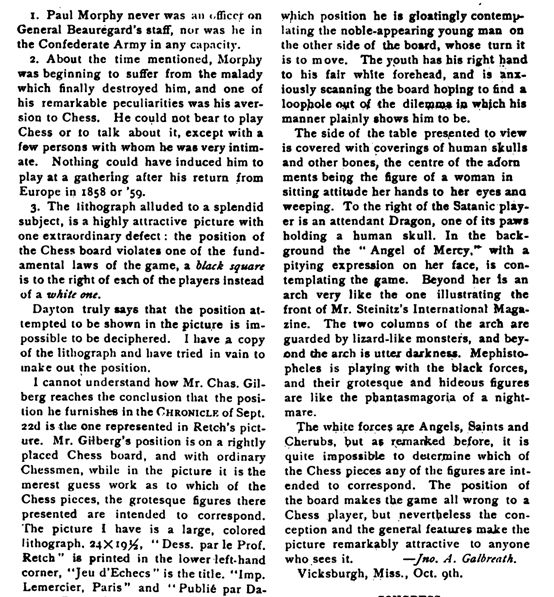
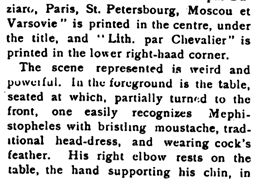 |
The Author Who First Posted The Morphy Anecdote Replies
On page 142 of the October 27, 1888 issue (Volume III, Number 17) G.R.F., the person who first posted the Morphy story in the Chronicle, (later identified as Gilbert R. Frith) resurfaced in support his earlier original anecdote stating that the veracity of the person who told him the story about Morphy's encounter with the Retzsch painting was “unquestionable”.
GRF’s letter to the editors of the Chronicle is also found below.
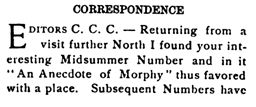 |
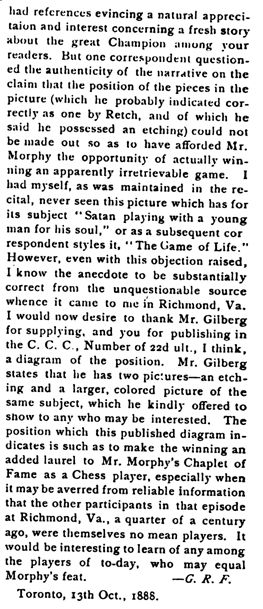 |
A final submission to the editors of the Chronicle in support of the "Morphy Anecdote" appeared in the January 3, 1889 issue (Volume IV, Number 1) on page 3 by its author Gilbert Frith. To view that page of the Chronicle on-line, first click here and then scroll forward three pages to the 3rd page of the first issue in January of 1889.
Frith first states his belief in the fact that Gilberg (in the September 22, 1888 issue of the Chronicle) had sufficiently refuted any objection to his story that someone like Morphy was unable to discern the position of the pieces on Retzsch's chess board. He then advises the Chronicle's readers of the willingness of none other than Morphy's host in Richmond the Reverend R.R. Harrison to refute Galbreath's other two objections to the Morphy story previously found in the October 20, 1888 issue of the Chronicle.
In addition to the on-line Columbia Chess Chronicle link provided above, Gilbert R. Frith's last submission in support of his story about Morphy and Retzsch's painting is set forth below.
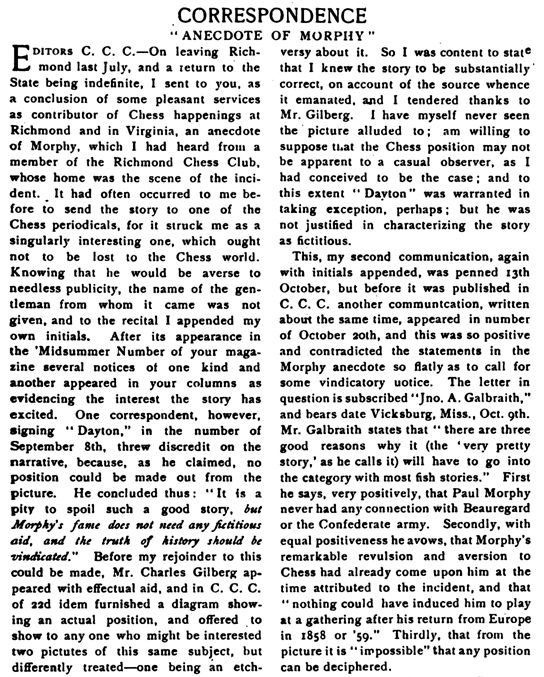

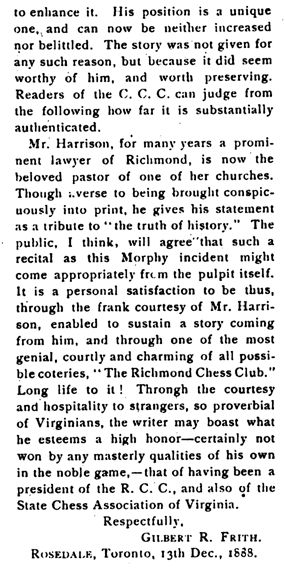 |
Frith Enlists The Support Of A Reliable Eye Witness-The Reverend R.R. Harrison
The Reverend R.R. Harrison (previously a prominent lawyer in Richmond Virginia) was willing to discard
the anonymity originally provided to him by Frith in the original anecdote. In an extensive two page letter to the Chronicle the Reverend Harrison verified the basic facts of the Morphy story told by Frith in the original posting of the anecdote. He also corrected the date of Morphy's visit to Richmond and Galbreath's first objection that Morphy did not serve on General Beauregard's staff in the confederate army. Harrison's two page letter begins on the last page of Frith's letter. If you are no longer viewing Frith's last letter on-line, click here and scroll down four pages.
The complete text of the Reverend Harrison's two page letter to the Chronicle is also provided below.
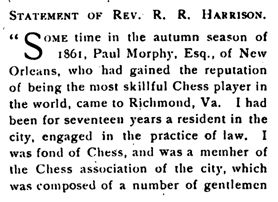
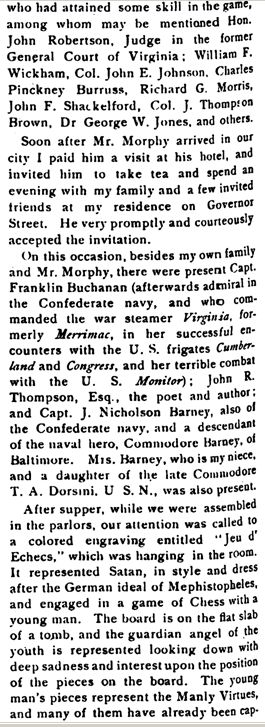 |
 |
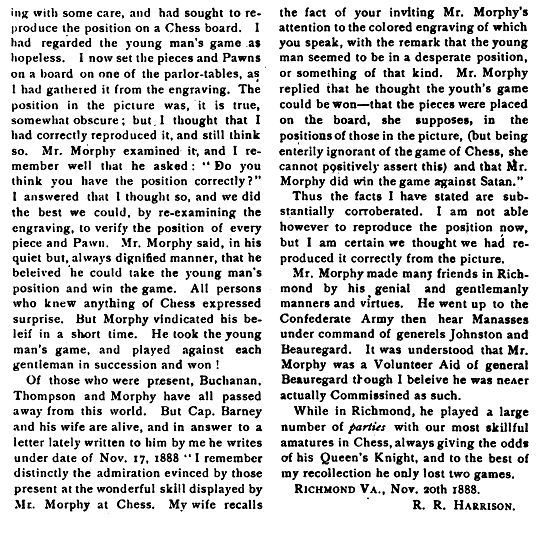 |
The Significance Of Harrison's Eye Witness Account
There a number of significant facts in Harrison's personal account that tend to corroborate the veracity of the Morphy story. He lists, for example, a number of highly respected eye witnesses who were physically present in his home on the evening Morphy purportedly won the chess game for the young man. Harrison also points out that the occasion of Mr. Morphy’s visit to the Richmond Virginia area did not occur in 1868 (as erroneously stated by Mr. Frith in his initial account of the event) but rather in the autumn of 1861 thereby effectively refuting point #2 of Galbreath’s October 20th letter to the Chronicle suggesting the Morphy story was not true because it took place in Mr. Harrison’s home at a time when Morphy had allegedly lost interest in the game.
Harrison also recounts his
own attempt to duplicate the position of the chess pieces in his color copy of
the Retzsch lithograph and also the fact that Morphy reviewed the lithograph
with him that evening and concurred with Harrison’s
placement of the chess pieces:
|
"Mr. Morphy examined it, and I remember well that he asked: “Do you think you have the position correctly?” I answered that I thought so, and we did the best we could, by re-examining the engraving, to verify the position of every piece and pawn. Mr. Morphy said, in his quiet but, always dignified manner, that he believed he could take the young man’s position and win the game. All persons who knew anything about Chess expressed surprise. But Morphy vindicated his belief in a short time. He took the young man’s game, and played against each gentleman in succession and won!” |
The Reverend Harrison offered further corroboration of the above facts by referencing a letter he had recently received on November 17, 1888 from a Captain Barney who had been present with his wife at Harrison’s home that night, had witnessed Morphy’s easy defeat of the position of the Devil’s chess pieces in Retzsch’s lithograph and who had further corroborated the truth of the original anecdote!
Regarding Galbreath’s objection to the story because Morphy was never a member of the confederate army under General Beauregard’s command, the Reverend Harrison makes short shrift of that relatively shallow historical objection:
|
“Mr. Morphy made many friends in Richmond by his genial and gentlemanly manners and virtues. He went up to the Confederate Army then near Manassas under command of generals Johnston and Beauregard. It was understood that Mr. Morphy was a Volunteer Aid of general Beauregard though I believe he was never actually Commissioned as such.” |
|
Galbreath’s objection that the chessboard was incorrectly presented in the Retzsch painting or illustration is not addressed at all by Harrison. That particular objection apparently did not require comment. A review of the painting sold by Christie's in October of 1999 shows the chess board to properly display a white square to each player’s far right. |
 Source: Christie's |
Conclusion
All of the above posts to the cited issues of the 1888 & early 1889 Columbia Chess Chronicle should be a source of great satisfaction for the legitimacy of the Paul Morphy story to anyone who has ever told the story of a chess master's defeat of the Devil's chess position in the Retzsch masterpiece. It should be a source of additional satisfaction for any inspirational speakers or Christian ministers and pastors who have, at any time, offered their own version of the Paul Morphy story (no matter how creative their particular version might have been) to now know that the Reverend R.R. Harrison, the man who was the original source of this fascinating and remarkable story, not only became a man of the cloth after a legal career but successfully defended the truth of his original story before all readers of the Columbia Chess Chronicle!